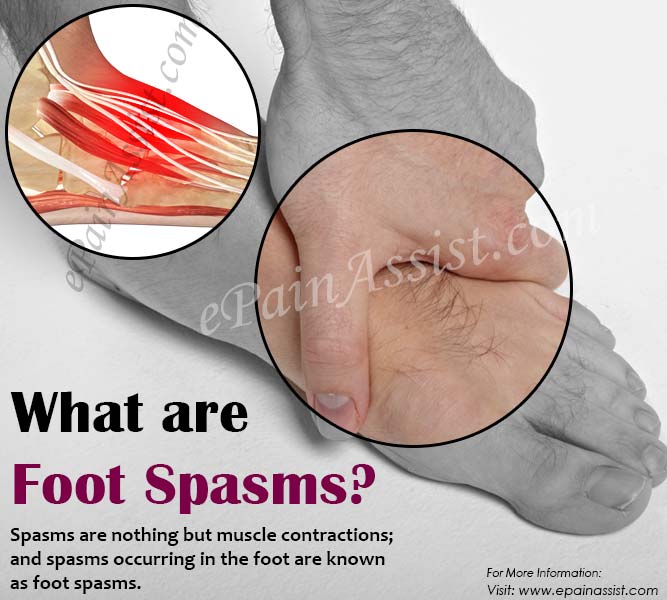What are Foot Spasms?
Spasms are nothing but muscle contractions; and spasms occurring in the foot are known as foot spasms. Spasms are often brief in duration; however, they can be severe and painful.

What are the Causes of Foot Spasms?
There is no clear cause of Foot Spasms. Possible causes of foot spasms are:
- Brain disorders, such as multiple sclerosis, Parkinson’s disease, Huntington’s disease and dystonia.
- Chronic kidney disease and dialysis.
- Mononeuropathy or polyneuropathy.
- Dehydration can cause foot spasms.
- Injury or any disease of the peripheral nerves.
- Foot spasms can also be caused due to heavy exercises.
- Hyperventilation occurring with anxiety.
- Pregnancy; Foot spasms are common during the third trimester.
- Increased phosphate levels in the body.
- Overuse of the muscles occurring during sports or any other intensive physical activity.
- Thyroid disorders.
- Decreased levels of calcium or magnesium in the body can also cause foot spasms.
- Vitamin D deficiency.
- Use of certain medications.
What are the Associated Symptoms of Foot Spasms?
Different symptoms of Foot Spasms depend on the cause and include: Cramping, muscle weakness, fatigue, tingling or numbness, twitching, involuntary and purposeless rapid motions of the affected foot. Elderly individuals often feel nighttime foot spasms.
What are the Tests Done for Foot Spasms?
Physical exam and medical history regarding the patient’s symptoms is taken.
Blood and urine tests can be done to find out magnesium and calcium levels, hormone levels, Vitamin D levels and kidney function tests.
What is the Treatment for Foot Spasms?
- The underlying cause of Foot Spasms should be treated to relieve the spasms. If decreased vitamin D level is the cause of Foot Spasms, then vitamin D supplements can be prescribed along with Calcium.
- Stretching exercises can be done to relieve Foot Spasms as these stretches help in keeping the muscles flexible and prevent them from getting tighter or shorter.
- It is important to be active to keep muscles in good condition. Aerobic exercises such as swimming and strength building exercises help in strengthening the muscles and keeping Foot Spasms at bay. However, care should be taken to avoid excessive exercise.
- It is important to drink plenty of water and other fluids throughout the day, especially during exercise to prevent dehydration and Foot Spasms.
- Over-the-counter pain relievers can be taken to relieve the pain occurring from foot spasms.
- Perform massages frequently and daily on the foot as this also helps in relieving and preventing Foot Spasms.
- If you’re lying down or sitting when experiencing foot spasms then stand up and put weight on the affected foot. Then gently flex your foot to stretch the muscles and keep it flexed till the spasm and pain subsides
- Icing or warm compresses to the foot also helps in relieving the foot spasms. Alternatively, the foot can also be soaked in warm water to relieve foot spasms.
How to Prevent Foot Spasms?
Stretching: Stretching of the muscles should be done before and after any exercise and after prolonged rest. If foot spasms are occurring at night, then stretch your legs and foot before going to sleep. This will relax the muscles and prevent foot spasms during sleep.
Hydration: Make sure that you are hydrated by drinking plenty of water throughout the day to prevent Foot Spasms. The body needs more hydration when exercising or during hot and dry weather. So make sure to drink extra water during this time to keep the muscles relaxed and hydrated.
Good Posture: It is important to adopt good posture when standing and sitting and always keep both the feet flat on the floor. Sitting with your legs twisted or crossed triggers foot spasms.
Healthy Diet: Follow a diet rich in fruits and vegetables. Decrease alcohol consumption to prevent foot spasms.
Medications: Certain medications cause Foot Spasms as their side effect. Ask your doctor if you can change these medicines to prevent foot spasms.
Wear Proper Footwear: Avoid wearing heels and uncomfortable shoes and wear proper fitting shoes to avoid Foot Spasms.
- Mayo Clinic. “Muscle Cramp” https://www.mayoclinic.org/diseases-conditions/muscle-cramp/symptoms-causes/syc-20350820
- American Academy of Orthopaedic Surgeons. “Muscle Cramps.” https://orthoinfo.aaos.org/en/diseases–conditions/muscle-cramps
Also Read:
- Proper Shoes for Pes Cavus (High Arches) : Support, Comfort, and Foot Health
- How Do I Know If My Foot Pain Is Serious?
- What Causes Toe Spasm? Home Remedies and Exercises to Relieve It
- What Causes Calf Cramps & How to Get Rid of it?
- Foot Cramps or Toe Cramps: Causes, Symptoms, Treatment, Ways To Get Rid of Cramps
